This article contains affiliate links. We may earn a small commission if you purchase via these links.
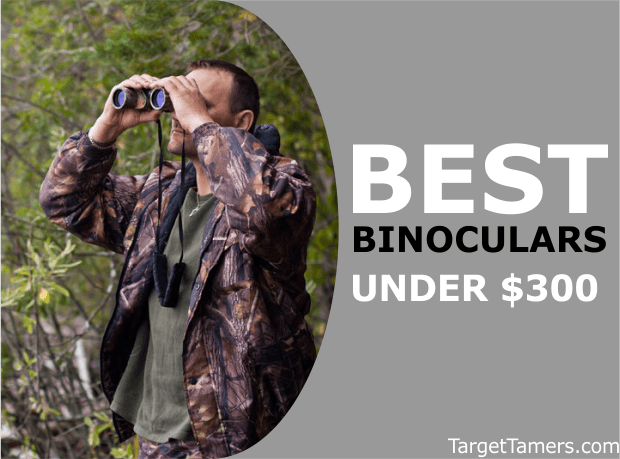
Stretch every penny to get the best of what's in the binocular market.
You're looking at high quality glass, premium coatings, and ultimate durability.
You should also expect to see extra perks included that'll make you a happy Glasser.
That's what $300 buys you - happiness!
Top Binoculars Under $300
This price range offers premium binoculars without getting too crazy and is an ideal budget to have when looking for a quality optic. Rarely do you need to spend more unless you desire every bell and whistle.
But, if you're happy with high-end quality at average cost, this is it.
For a beginner, you'll land yourself a great optic. For the intermediate and pro, this is going to be enough to land you something top-notch and dependable for the field.
For the perks, frills, and twills that will get the job done, 300 dollars are going to go a long way!
| IMAGE | PRODUCT | DETAILS | |
|---|---|---|---|
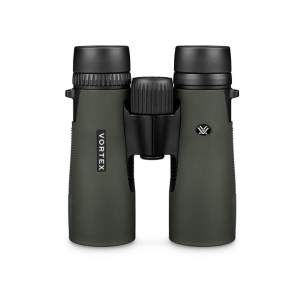 | Vortex Optics Diamondback HD 10x42 |
| CHECK PRICE |
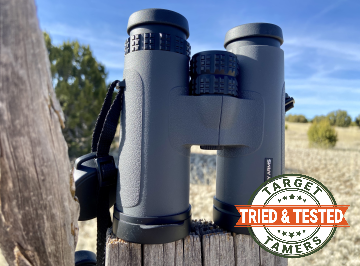 | Primary Arms GLx ED 10x42 |
| CHECK PRICE |
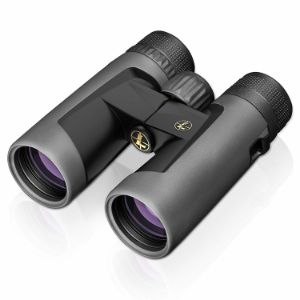 | Leupold BX-2 Alpine HD 10X42 |
| CHECK PRICE |
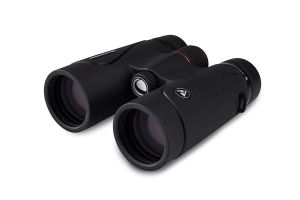 | Celestron TrailSeeker 8x42 |
| CHECK PRICE |
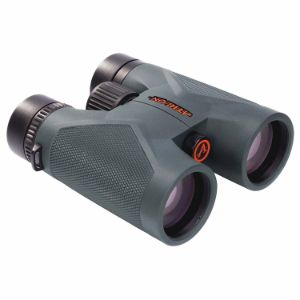 | Athlon Optics Midas 8X42 |
| CHECK PRICE |
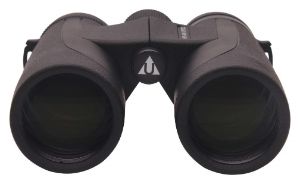 | Upland Optics Perception HD 10X42 |
| CHECK PRICE |
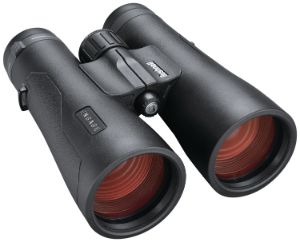 | Bushnell Engage 12X50 |
| CHECK PRICE |
Why Trust Us?
After hundreds of hours of hand-testing binoculars in the field and at the range, and thousands more hours researching and writing about them, we feel we earn the title of experts when it comes to optics!
We purchase as many of the optics for our tests as possible, and run them through their paces to make sure they will perform at the range and in the field.
Our combined decades of experience from camping and hunting, to big game hunting and competitions has been integral in putting together this round-up of the best binoculars under $300.
Get the inside scoop on how we test optics here.
The 7 Best Binoculars Under $300
1. Vortex Diamondback HD 10x42 – Best Overall
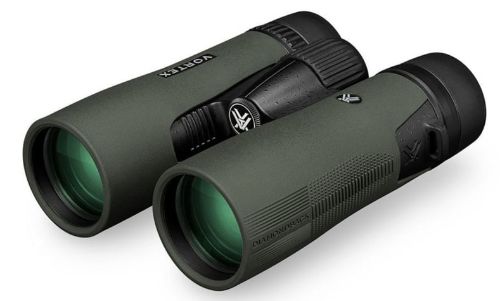
When Vortex overhauled the Diamondback series, they not only brought HD elements to the picture but also upgrades to the build quality. Still kept at an affordable price, the Diamondback HD is still the epitome of guaranteed value.
Pros:
- HD optics
- Adjustable eyecups
- Lightweight
- Argon gas
- Magnesium chassis
Cons:
- Accessories complaints
Optically, the HD model performs well but there is some off-edge coma but nothing outside of the expected performance for the price range. It is sharp and clear at the center even out to extended distances.
While Vortex only discloses an HD Optical System with “select glass elements,” there is no other information and minor CA is apparent. Overall, it offers optical quality representative of its price point and is one of the best available compared to similarly priced alternatives.
More upgrades come in the form of specialized roof prism coatings with PC dielectric layers. It also sports a magnesium chassis and argon-purged barrels which both are usually features only seen in high-end models.
For its 10x42 platform, it has less than average FOV of 330 feet/1000 yards, and the eye relief of 15mm will be annoying for some glasses wearers, but it does have multi-position eyecups. What it does prove to do well for its configuration is keeping weight to a minimum. It’s one of the lightest binos at 21 oz for its well-made build.
It comes with many accessories including a harness and separate GlassPak case. Some are more critical than others saying the case is noisy, doesn’t quite fit properly, and that the rainguard should be tethered, etc. Think of it this way. Take what you get as binos that cost 4x more don’t come with the extra freebies.
2. Primary Arms GLx 10x42 ED – Best ED Glass Binoculars
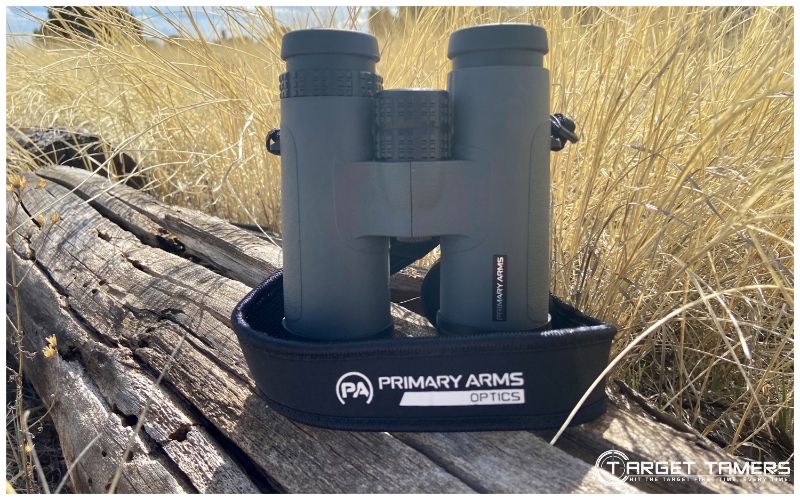
Offered at a competitive price point with the most competitive manufacturers, Primary Arms delivers the GLx 10x42 ED binoculars to rock the boat. In the spirit of things, I field-tested the GLx binos literally on and off the boat to test its optical quality and if it’s worth considering.
Pros:
- ED glass
- Wide FOV
- Easy to focus
- Lightweight/compact
- Fog/waterproof
Cons:
- Eye relief
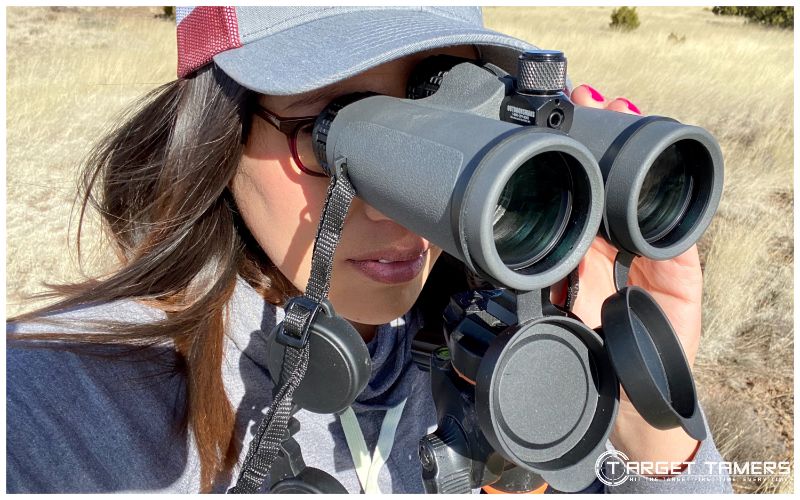
The GLx has 15.2 mm of eye relief, and this is on the short side for glasses. I tried it, but the eyepieces are butted right up to my frames, so it’s not the most forgiving binos around. Fortunately, I can use the diopter to correct for my vision, so eye relief was a non-issue going forward.
I can speak to the difference between the SLx and GLx binoculars and how there is a visible leap in optical quality thanks to the ED glass. The sharpness and clarity achieved provided excellent results in the field when bird watching.
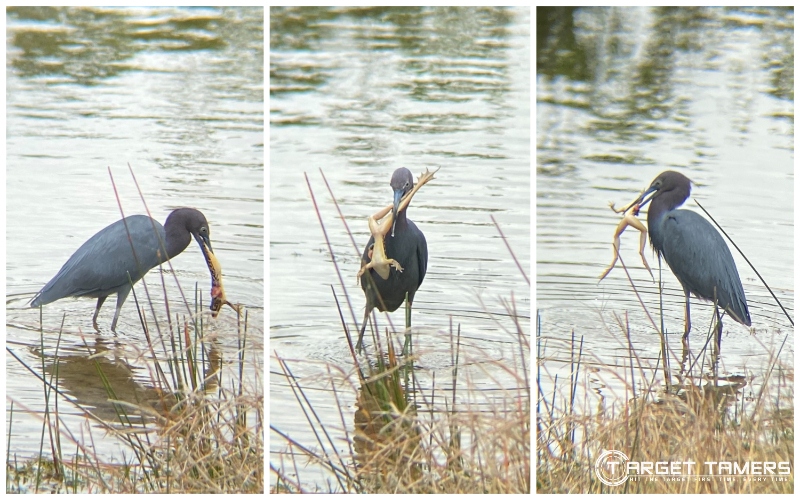
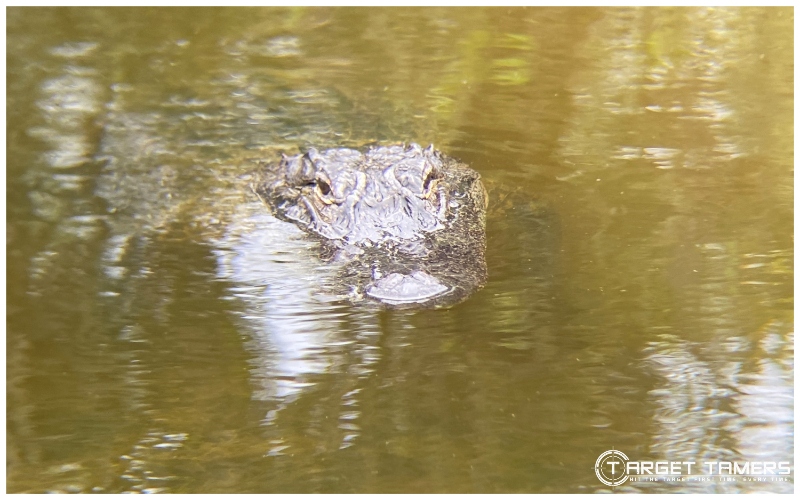
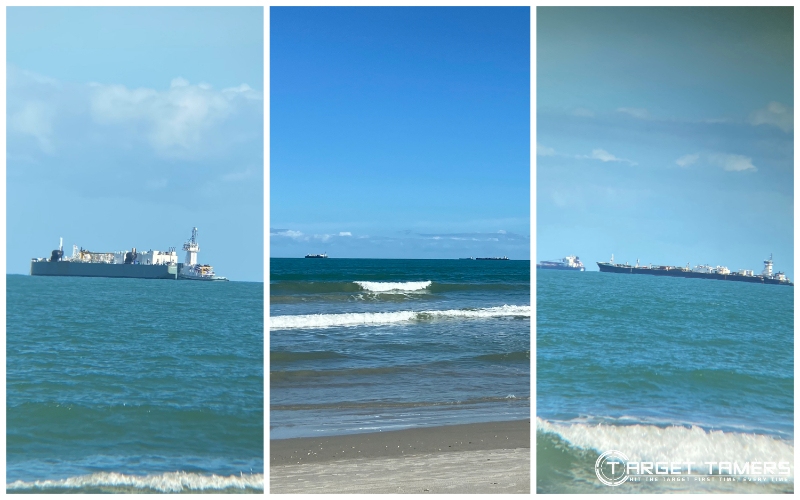
Getting close-ups on birds of all kinds was a rewarding experience, and it certainly kept me at a safe distance when I was feeling stalked by gators. For a 10x42 configuration, it has a great 341 ft field of view.
Though not specific to marine use, I did use it while in and out of the water to observe ships, boat wreckages, and wildlife, and I found it sufficient for my amateur needs.
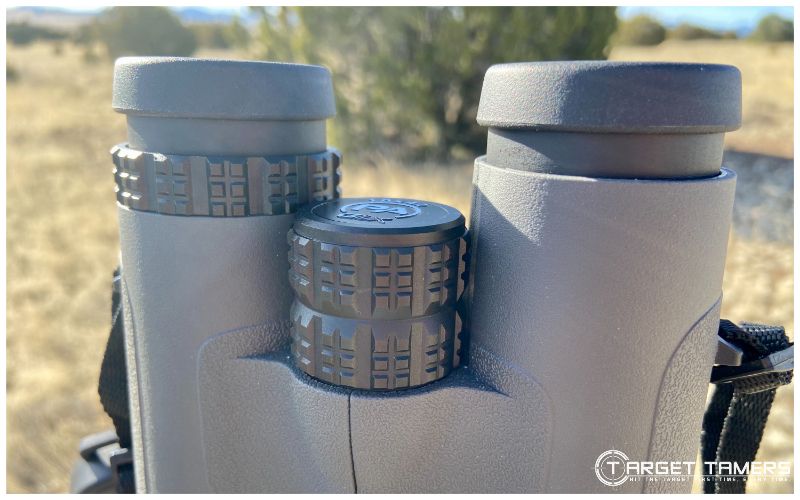
The oversized focus knob naturally prompts two-finger use, and the diopter offers resistance but is definitely not as stiff as I’ve experienced with other binoculars.
Primary Arms hit it on the nose with the GLx binoculars. They’re priced right, rugged, and they impressed my senses with its optical supremacy. I’m a megafan.
3. Leupold BX-2 Alpine HD 10x42 – Best for Hunting
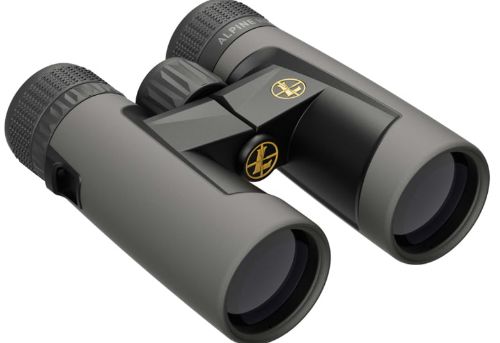
The latest release of the BX-2 Alpine binoculars maintains their compatibility for all things outdoors. It’s in the upper spectrum of the entry-level category and is one of the best in the industry for quality and value.
Pros:
- Twist-up eyecups
- Advanced Optical System
- Extreme Climate Exposure
- Fog/waterproof
- Included accessories
Cons:
- Focus & eyecup play
The drawback is that there is some minor play in the focus wheel and the eyecups may give you some grief. With 15mm of eye relief, it doesn’t fit at as tight as some would like but is a little too tight for glasses wearers.
The Alpine HD binoculars have a good FOV of 342 feet/1000 yards for its 10x42 configuration and is on the lightweight end of things for weight at 28oz. Its specs are well within standard perimeters for mid-size, all-purpose binoculars.
While the optical quality is exceptionally well-done for its mid $200 price point, it shouldn’t be compared to binos twice the price. It works well for average hunting distances and in lowlight. With fogproof and waterproof housing, it’s ready to handle the conditions of a spot and stalk Winter alpine hunt.
It’s been exposed to extreme climate temperatures and is rated for -40 to 160-degrees Fahrenheit. The glass is scratch and smudge resistant with an exterior lens coating to prevent accidents that happen while in the brush.
It comes with Pro Gear accessories including a GO Afield binocular harness and other tidbits. For a binocular that comes ready for chest strapping, harsh hunting conditions, and all at the low price of under $300 with a Lifetime Guarantee protecting it, the choice to choose the a cheap hunting binocular is done.
4. Celestron TrailSeeker 8x42 Binocular Review
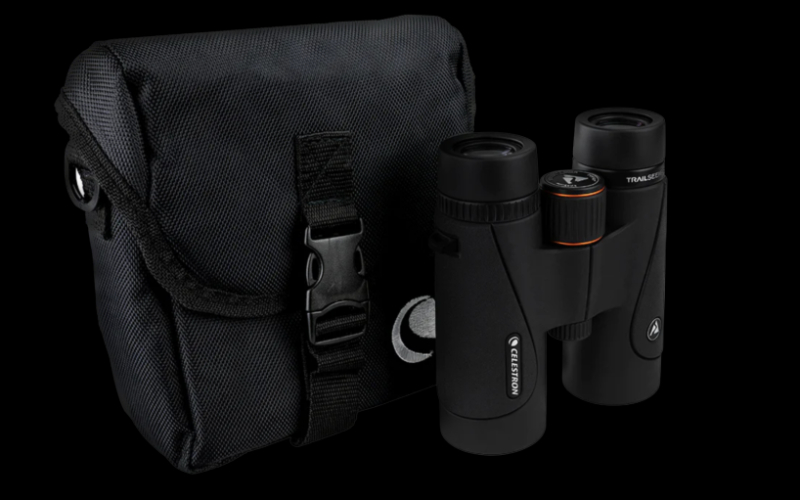
This Trailseeker binocular is from the non-ED line. This is about as good as it gets before you start browsing just over $300. Never mind that, as a roof prism bino it does have dielectric, phase, and FMC coated glass. That’s right within range for a binocular at this price point.
Pros:
- Wide FOV
- Special roof coatings
- Metal parts
- Fog/waterproof
- Tripod adaptable
Cons:
- A little heavy
The Trailseeker 8x42 is a tad on the heavy side – and that’s with my extreme criticism. It comes in at 5.5 x 5.1 x 2” in size which is right around what a mid-size binocular should be, but it weighs about the same as a 10x42 for today’s standard. Fortunately, I really like that even though it’s an 8x42 configuration, it can be tripod mounted.
As a roof prism bino, Celestron made sure to give the prisms what they need to perform at their best – phase and dielectric coatings. Even though it doesn’t have ED (Extra-low Dispersion) glass, having those coatings alone will make a difference versus roof prism binos without.
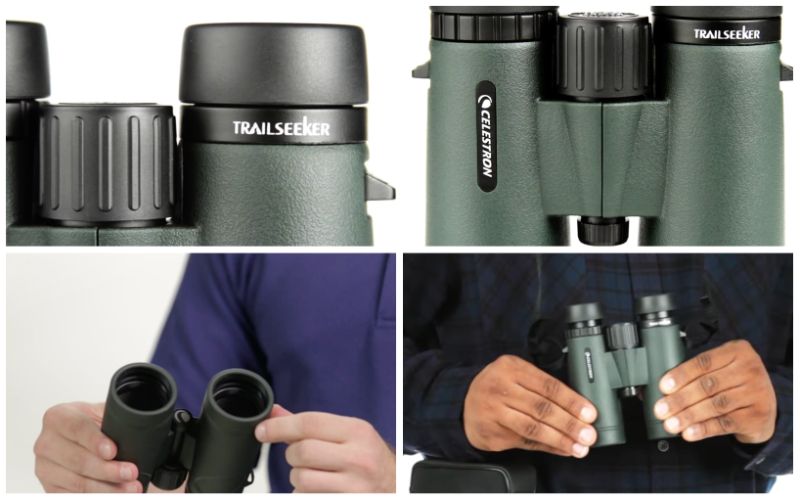
8x42 binos are going to have a wider FOV than larger configurations, but still, I like the wide linear 426 ft FOV that will be great for scanning, hunting, bird watching, and more.
What I give credit to Celestron for is that they also outfit their binoculars with the works. It has rubber armor, is waterproof, and it’s nitrogen-filled, so it’s fogproof. They’ll stand up to dust, rain, and general knocks about when you’re 4-wheeling somewhere rural.
Some have complained about the rainguard (one-piece eyepiece cap) falling off. Just a tip – you can usually tether the ends of the neck strap around one side of the rainguard too. You’re welcome.
5. Athlon Optics Midas 8X42 Binocular Review

We're impressed and you should be, too. Athlon reckons these binoculars have been touched by Midas himself because these pair are said to set the gold standard for binoculars in their class. What class is that?
It looks like it's the high-end, luxury class with the unbelievably low-end price tag.
Pros:
- Price
- ED glass
- FMC optics
- Specialized coatings
- Wide FOV
Cons:
- Squishy focus knob
Everyone agrees - the Midas bino is a premium optic. With FMC optics and ED glass, image quality is promised to be sharp, free of color fringing, and a reflection of true color fidelity. But, it wouldn't be the gold standard if it didn't have more.
Specialized coatings include an ESP Dielectric coating and a phase coating to get those roof prisms up to par. An XPL Protective Coating does what you expect - you guessed it, protects the objectives from debris, dirt, and scratches.
Its specs are especially attractive with a wide FOV of 426 ft (@1000 yds), a long 17.2 mm of eye relief, and light weight of 23.3 ounces. With an 8x42 configuration, you're set to hunt, stroll, or bird watch at your leisure without the constraints of large-sized binoculars and yet with full-size performance.
But, there are rare instances of the Midas bino having a squishy or over-greased focus knob. Additionally, the rainguard (one-piece lens cover) that comes included with the Midas is unfortunately and incorrectly seen as "broken" by buyers, however, this is a design feature.
The rainguard has loops on either side that allows for the neck strap to be looped through before attaching to the binocular. One loop on the rainguard has a slit that allows it to be quickly removed from one side of the strap to dangle or hang on the side.
It's a feature that allows for versatile attachment or detachment.
With excellent optics, seductive specs, a decent price, and accessories that are actually better than what most people can wrap their heads around - we think the Midas binoculars may just have been touched by Midas himself.
6. Upland Optics Perception HD 10X42 - Best Value
- Exceptional Clarity with Extra-Low Dispersion (ED) Glass
- Built to Survive the Hunt: Waterproof, Fogproof, and a Durable Rubber Body
Who is Upland Optics? They're an American brand out of Idaho. They're a brand that loves hunting. They're an up-and-coming manufacturer, and we like what they stand for. Apparently, so do many others that are buying up their Perception HD binoculars.
Pros:
- Price
- ED glass
- Compact
- Lightweight
- Fog/waterproof
Cons:
- Focusing issues
The Perception HD binoculars propel themselves into this price range with quality features specifically outfitted for the hunter. The first thing we notice is the ED glass that should be a staple for all binoculars in this price class. Color fringing will be a thing of the past and edge-to-edge clarity will be your future.
But, achieving ultimate clarity and resolution can be hard to attain if you can't focus your optic. It doesn't seem to happen very often, but there are a few complaints of focusing issues that includes being too stiff or not fine enough.
However, this very well could be a subjective complaint and/or user error as many forget to set the diopter.
Additional features that are important to hunters is the size. If it's too heavy and bulky to use as a practical tool in the hunt, it may as well stay in the truck.
Fortunately, Upland Optics are hunters themselves, and so they know the 23 oz weight and 5.5 x 5 x 2 in size is ideal when you're hiking, loaded with a rifle and pack, and sweating bullets under Mossy Oak camo.
They also know your binoculars must be able to withstand the unpredictable conditions of a hunt be it rain, snow, or the accidental tumble from the tree stand.
That's why the Perception HD is rubber armored, fogproof, and waterproof and is one of the best hunting binoculars under $300.
With all these quality features right within your price range, we'd say the Perception HD binoculars allow you to perceive the world differently. You might even say, better.
7. Bushnell Engage DX 12X50 Binocular Review
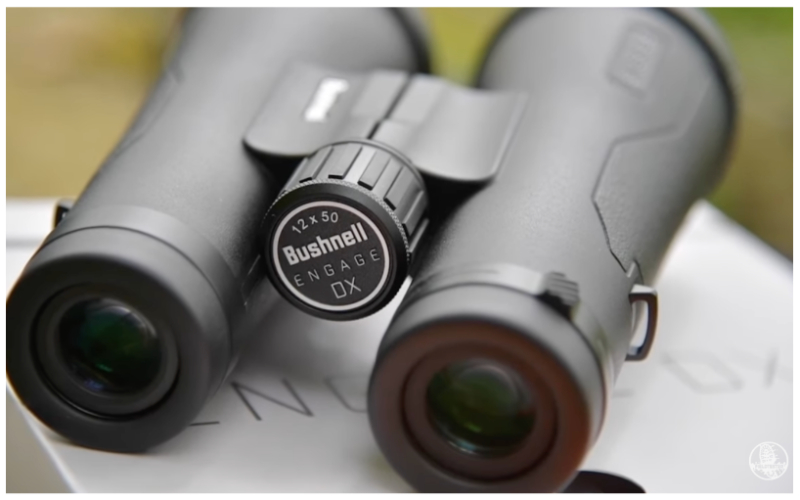
If your hunting style, backpacking adventure, and wildlife tour allows for it, go big with a 12x50 binocular. Get more light and sight by doing yourself right with the Engage binocular.
Pros:
- Price
- High power
- 50 mm apertures
- Tripod adaptable
- Specialized coatings
Cons:
- Non-ED model
The Bushnell Engage DX is a non-ED glass binocular. That's why this configuration (magnification + objective lens size) is so much cheaper than other Engage binoculars. So, though you'll miss out on the additional glass elements to minimize aberrations, you still have specialized coatings to do the heavy work.
It has dielectric and PC-3 phase coating technologies. Though the latter is a proprietary formula, these coatings are needed on a roof prism bino to bring lightwaves parallel to the same focal point. All in all, I like that it has them, even though it's without ED glass, because it means that it'll be sharper and brighter than roof prism binos without it.
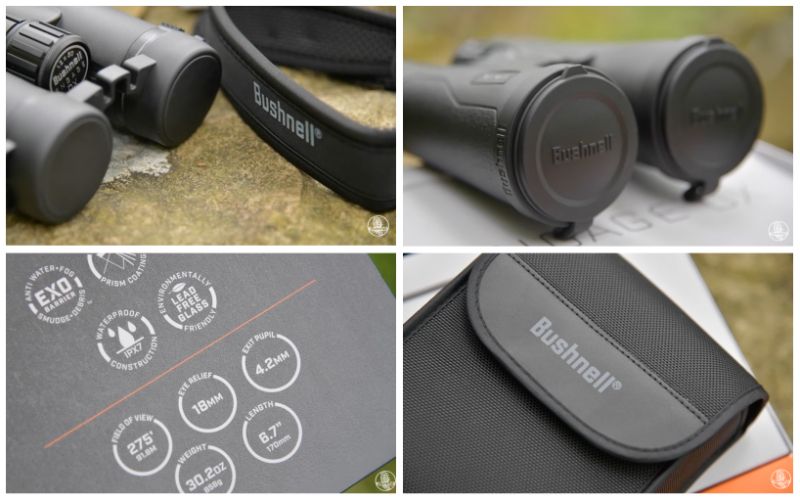
The large 50mm apertures certainly promise some low-light action. Bushnell's EXO Barrier Protection is carefully layered onto the objectives to repel dirt, dust, rain - you name it, and protect against scratches when you forgetfully wipe with your sleeve.
Taking a once-over look on the body, it has a metal chassis with rubber armor for shock, impact, and scratch protection. It comes in at average weight of 30.2 oz for today's standard for a 12x50. I think that's great considering 10x42s used to weigh that.
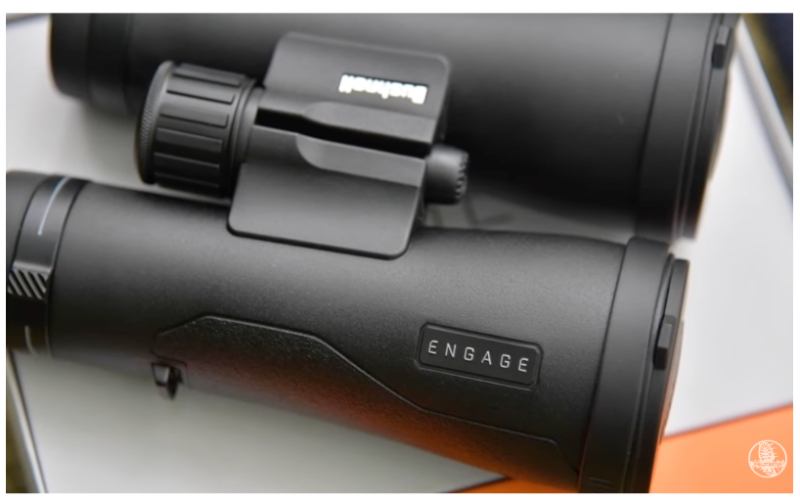
I like the 12x magnification that takes me a little bit further over open spaces, and some can consider the tripod adaptability a must-have - which it does have.
An IPX7 rating, twist-up eyecups, and FMC optics finish up what I have to say about the Engage DX binoculars. That's a whole mouthful of features right there, and this is the epitome of quality to expect around $200.
What to Look for in Binoculars in the $200-$300 Price Range
With three hundred dollars to spend on a brand new binocular, you'll want the very best. The very best should include top-notch glass coatings, comfortable eye relief, and a high quality build. Extra perks are a must-have in this price range.
Anything less needs to be kicked down a notch to the under $200 budget category.
You should also be looking out for a decent warranty for your binocular buy. Spending this kind of cash on a binocular should land you in the best of what your potential brand has to offer.
Configuration & Glass
In general, many binoculars in this price range will be roof prism binos. There will be some Porro prisms but the better they are, the more expensive they become. With roof prism binos, you also must demand quality prism-specific coatings. Without them, a roof prism bino will be left wanting.
| Binocular | Power | Prism Type | Glass Type |
|---|---|---|---|
| Vortex Optics Diamondback HD | 10x42 | Roof Prism | Bak-4 |
| Primary Arms GLx ED | 10x42 | Roof Prism | Bak-4 |
| Leupold BX-2 Alpine HD | 10x42 | Roof Prism | Bak-4 |
| Nikon Monarch 5 | 8x42 | Roof Prism | Bak-4 |
| Athlon Optics Midas | 8x42 | Roof Prism | Bak-4 |
| Upland Optics Perception HD | 10x42 | Roof Prism | Bak-4 |
| Bushnell Engage | 12x50 | Roof Prism | Bak-4 |
Eye Relief & Exit Pupil
The eye relief is a unique specification to each binocular. Even binoculars in the same series from the same manufacturer can have different eye relief specs. I would recommend that 15mm is the minimal amount of eye relief someone with glasses would want to consider. The longer, the better.
The exit pupil specification is the cone of light that enters the eye. The larger, the more light there is to take in. This is usually a good indication of how useful they can be in low light, however, there are other factors that also determine lowlight performance.
| Binocular | Eye Relief | Exit Pupil |
|---|---|---|
| Vortex Optics Diamondback HD | 15 mm | 4.2 mm |
| Primary Arms GLx ED | 15.2 mm | 4.2 mm |
| Leupold BX-2 Alpine HD | 15 mm | 4.2 mm |
| Nikon Monarch 5 | 19.5 mm | 5.3 mm |
| Athlon Optics Midas | 17.2 mm | 5.25 mm |
| Upland Optics Perception HD | 15.2 mm | 4.2 mm |
| Bushnell Engage | 15 mm | 4.1 mm |
Field of View
What is Field of View? This is the measured distance of an area (measured at 1000 yards) that is seen through the sight picture from edge to edge. Wide fields of view are inherent to low configuration binoculars while they become narrower the larger they get.
Even with that said, FOV specs are unique to each model even from the same series and manufacturer.
Wide FOVs are great for scanning, hunting, bird watching, and more!
| Product | Field of View |
|---|---|
| Vortex Optics Diamondback HD | 330 ft (@ 1000 yards) |
| Primary Arms GLx ED | 341 ft (@ 1000 yards) |
| Leupold BX-2 Alpine HD | 342 ft (@ 1000 yards) |
| Celestron Trailseeker | 426 ft (@ 1000 yards) |
| Athlon Optics Midas | 426 ft (@ 1000 yards) |
| Upland Optics Perception HD | 340 ft (@ 1000 yards) |
| Bushnell Engage DX | 273 ft (@ 1000 yards) |
Size
In general, at this price point most binoculars are going to have 8x42 and 10x42 configurations. There may be some odd ones out that offer 12x50 and larger which can be a good buy for the money if the glass and coatings are any good.
This brings the common picks under $300 in the 5” average size and around 16-24 oz in weight - the realm of mid-size binoculars. Though this is considered lightweight, some might still want to consider mounting it to a tripod for extended glassing or for steadier viewing.
| Product | Dimensions | Weight |
|---|---|---|
| Vortex Optics Diamondback HD | 5.7 inches (L) | 21.3 oz |
| Primary Arms GLx ED | 5.5 inches (L) | 23.7 oz |
| Leupold BX-2 Alpine HD | 6.2 inches (L) | 28 oz |
| Celestron Trailseeker | 5.5 x 5 x 2 inches | 23 oz |
| Athlon Optics Midas | 5.7 x 5.2 inches | 23.3 oz |
| Upland Optics Perception HD | 4.9 x 2 x 5.5 inches | 25.7 oz |
| Bushnell Engage DX | 5.5 inches (L) | 30.2 |
Durability
For the money, binoculars under $300 should be waterproof and nitrogen-purged for fogproof protection. This provides confidence when using them in the field that they’ll hold up to the conditions to keep you glassing.
| Product | Waterproof | Fogproof |
|---|---|---|
| Vortex Optics Diamondback HD | Yes | Yes |
| Primary Arms GLx ED | Yes | Yes |
| Leupold BX-2 Alpine HD | Yes | Yes |
| Celestron Trailseeker | Yes | Yes |
| Athlon Optics Midas | Yes | Yes |
| Upland Optics Perception HD | Yes | Yes |
| Bushnell Engage DX | Yes | Yes |
Warranty
Fortunately, binoculars tend to come with pretty good warranties these days. From manufacturer warranties like Leupold to Vortex, they’re now pretty competitive, so it’s hard to go wrong if you stick with brand name.
| Product | Warranty |
|---|---|
| Vortex Optics Diamondback HD | VIP Warranty |
| Primary Arms GLx ED | Limited Lifetime Warranty |
| Leupold BX-2 Alpine HD | Lifetime Guarantee |
| Celestron Trailseeker | Limited Lifetime Warranty |
| Athlon Optics Midas | Lifetime Warranty |
| Upland Optics Perception HD | Limited Lifetime Warranty |
| Bushnell Engage DX | Lifetime Ironclad Warranty |
$300 Buys You Luxury!
Here, you're seeing premium perks for only a few hundred bucks. You're getting the best of what the optic world offers. Sure, you can spend a heck of a lot more, but that extra money only enhances what you're already buying here.
There's only a few additional features that can be added to kick this budget higher, but this price range offers it all.
If you want to glass in luxury, $300 is all you need!
Further Reading
- Bushnell Fusion 1-Mile ARC Rangefinding Binoculars Review (w/ Angle Compensation)
- Celestron Outland X 10x42 Review - Popular Binoculars (Model 71347)
- Celestron TrailSeeker 8x42 Binocular Review (Model 71404)
- Bushnell Legend 10x25 Ultra HD Binocular Review - With Compact Roof Prism (Model 190125)
- How to Adjust Binoculars: 4 Essential Adjustments to Master Today




